This was published 4 years ago
How airline food is made: Food critics go behind the scenes
By Jill Dupleix and Terry Durack

Is it possible for an airline to cook something that isn't bland and anonymous, doesn't taste re-heated, and won't look thrown on a plate?
Good Food columnists and restaurant critics Jill Dupleix and Terry Durack go behind the scenes of airline food to offer their expert opinions.
Forget fear of flying. That's small potatoes, compared to a visceral fear of airline food. As two people who have dedicated their lives to seeking out true and authentic flavours both at home and abroad, we share a deep distrust of food on a plane, formed over decades of claggy fish, ungnawable beef, mystery soup, out-of-season tomatoes and squishy-soft bread.
In fact, we've travelled far and wide to avoid it. We've taken trains, cars and boats, instead of planes. We've taken our own food, so we don't have to eat theirs. (Ham and cheese sandwiches work best – soft white bread, plenty of butter and mustard – tightly sealed to protect from the drying pressurised air).
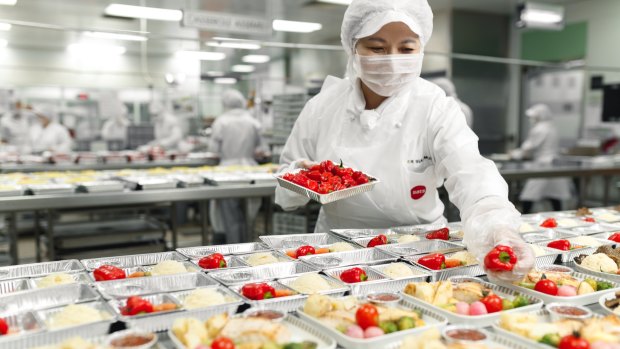
Airline food is all to do with your nose, not your taste buds.
On one spectacular occasion, we even flew first class. They eat caviar up there, you know. By the bucketload. You can have seconds, and thirds. And the champagne is top of the tree, and on tap. It's ironic, because generally, the only people who fly first class are drug lords, arms dealers, Hollywood stars and people who own Facebook and Google; none of whom eat or drink like normal people.
But the fact remains: airlines go to a lot of trouble to tell you what to do in case of emergency, but have no real advice on how to cope with their meal trays.
REALLY? WE HAVE TO WRITE ABOUT AIRLINE FOOD?
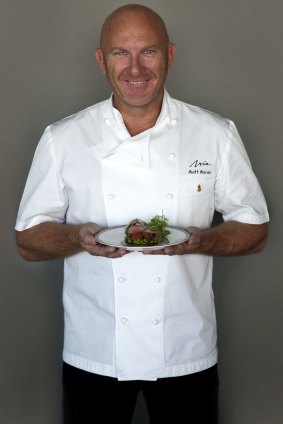
Australian chef Matt Moran creates dishes for Singapore Airlines' menu.Credit: Jennifer Soo
When Traveller invited us to attend Singapore Airlines' World Gourmet Forum, we said a very polite no. But we were curious. Is it at all possible for an airline to cook something that isn't bland and anonymous, doesn't taste re-heated, and won't look thrown on a plate?
What really happens at the forum in Singapore, when eight of the world's top chefs on the airline's International Culinary Panel, including our very own Matt Moran of Aria restaurant in Sydney and Brisbane, come together?
So we changed our minds and said yes. In a single day, we will meet the chefs as they introduce up to 50 new in-flight meals for the coming year; head out to the industrial catering kitchens of Singapore Airport Terminal Services (SATS) where up to 80,000 meals are produced every day; and review the dining experience in the air, in the way we would a restaurant.
What could possibly go wrong?
WHY AIRLINE FOOD HAS BEEN SO BAD, FOR SO LONG
Some researchers claim that at high altitude, we lose as much as 30 per cent of our ability to taste, and, given some of the things we've seen on airline trays, we have often been profoundly grateful for that fact.
The thing is, it's all to do with your nose, not your taste buds. If you can't smell your food, says Antony McNeil, global director of food and beverage for Singapore Airlines, you can't taste your food. "The combination of a dry cabin atmosphere and pressurisation means your nasal passages dry up and be less receptive," he says.
Hence your average airline's historic over-use of fat, sugar and salt, to overcome the bland, re-heated, anonymous food. Unforgettably, China Airlines once gave us small sachets of MSG with our lunch boxes, and Air Italia handed out miniature bottles of grappa (both of which helped, it must be said).
McNeil began his career as a young chef at Fanny's in Melbourne, followed by extended periods working with prestige hotel groups in China and the Middle East. He's seen how new technology is improving comfort levels for passengers.
"It's changing for the better," he says. "The technology in the new generation of aircraft has raised humidity levels and lowered cabin pressure, resulting in a far more comfortable experience."
SO WE BOOKED THE COOK
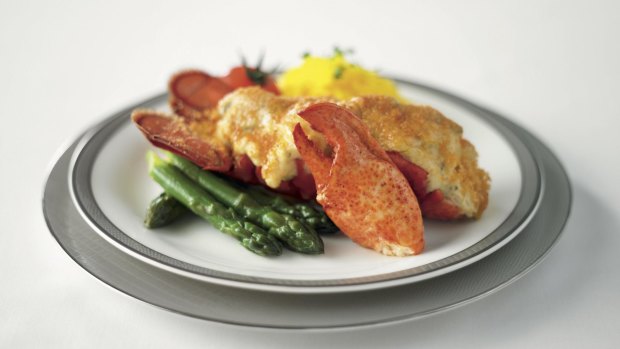
Well, this is fun. Since December, 2018, passengers in Singapore Airlines' premium cabins can actually go into their booking online and pre-order dishes from the inflight menus. On top of this, first and business class passengers can "Book the Cook", and pre-order main courses from a separate menu of up to 68 choices. The two biggest orders apparently, are lobster thermidor, and beef rib-eye with roast vegetables and garlic mash.
Given there is no tightly wrapped ham-and-cheese sandwich on the list, we order what we hope we will feel like for lunch in the air from Sydney to Singapore – chicken rice for her, and Indian lamb shank curry for him.
The online service attributes her dishes to him, and his to her, but no matter. Being married, we swap our dishes as a matter of course. His (her) chicken rice is a beauty; skin-on, lightly oiled, tender meat, with rice that smells and tastes of the chicken broth in which it was cooked. Her (his) lamb shank curry is OK, but a bit glumpy.
SPARE US: THERE'S A WELLNESS PROGRAM
The welcome address at the World Gourmet Forum by Singapore Airlines senior vice-president customer experience, Yeoh Phee Teik, spells out the future. "Our customers are paying more attention to their health and well-being whenever they travel," he says.
"Our award-winning chefs from the international culinary panel are on board with this wellness movement, creating new seasonal menus prepared in the lighter cuisine style, to enable customers to be able to eat just as healthily in the air as on the ground."
Just the week before, the airline had also signed up global wellness brand Como Shambhala to introduce "wellness cuisine" on flights out of Singapore from July 1, and a new wellness menu featuring specially curated dishes will be introduced across all classes.
We say it all depends on your understanding of wellness. Ours is eating salted almonds and cashews with a pre-dinner gin and tonic, followed by spicy noodles and red wine, then cheese, then chocolate. That makes us feel very well indeed. Please don't take our nuts away.
WHERE IT ALL HAPPENS
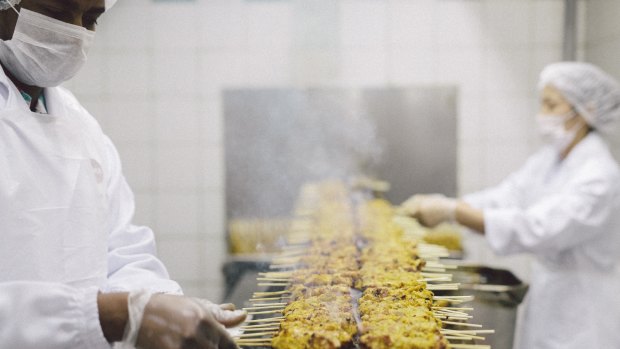
Singapore Airlines' food out of Singapore, its busiest hub, is produced by the Singapore Airport Terminal Services in North Changi. Just to have a gander at their production facilities, accessed via a link bridge from the administration building, we had to take off our watches, cover our shoes and wear hair nets, face masks and dustcoats.
Then we had to walk through a high-velocity, low-pressure air shower that dusted off any remaining surface-deposited particles. If they could have dipped us in sheep drench as well, they would have.
Australian-born Rick Stephen, who founded acclaimed Brisbane restaurant Raphael's in the 1980s, now runs the two massive kitchens as director of kitchen for SATS, with 1200 chefs reporting to him daily. Like a ringmaster, he sweeps us along corridors and across vast plains of conveyor belts and refrigerators, showing us the 19 separate kitchens that produce up to 80,000 dishes a day.
We peek into the specialist Japanese, Indian, Thai, Western and Muslim kitchens, another dedicated to peeling prawns, and another for the peeling of eggs. There's a room purely for controlled thawing, and a 24-hour bakery that churns out 110,000 baked items a day.
"We also make all our chocolates, all our own dressings, our dim sum for business and first, and have two cheese rooms," he says, before sneaking us in to a yet-to-be-launched computerised spice room, in which each spice will be electronically portioned and weighed.
One kitchen is devoted purely to pork, where we watch, mesmerised, as Martin, the long-standing master butcher, makes one perfect ballotine of truffle-studded pork and chicken farce after another; each of his movements as smooth and precise as clockwork. "If Martin is making meatballs, we don't have to weigh them," says Stephen. "It's 20 grams, followed by 20 grams, followed by 20 grams, all perfect."
The airline even has a simulated plane cabin inside the SATS facility that can become fully pressurised within 30 minutes. It's their secret weapon against blandness, says Stephen, because they can tweak and adjust the recipe knowing precisely what the pressure will do to the aroma and flavour.
Another discovery is a small chamber holding only a long, skinny robata grill glowing with red hot coals and wreathed in smoke. It looks like a holy place, a sacrificial shrine, and in a way it is.
The airline's famous Singaporean satays are cooked here; the marinated meat threaded by hand onto colour-coded bamboo skewers. The small grill still manages to cook 10,000 chicken satays, 2000 lamb satays and 1000 beef satays per day. "We wouldn't dream of using an electric grill or an oven," says Stephen.
THE FUTURE IS HERE
There are rows of blast chillers, forests of giant "combi" ovens, and an automated rice line that can cook 4000 portions an hour with just a three-man team. An automatic fryer does large batches without the need for human hand to work near hot oil; and a soup station makes 600 litres of chicken stock, and 300 litres of veal stock a day.
"All made fresh, from bones, with no powder bases," he affirms. "It makes such a big difference to the taste."
Automation and data-driven analytics are the way of the future, if the new operations facility launched by SATS in March 2019 is any indication. The dry-goods storage area itself is six storeys high, and cute delivery robots are used for transporting goods and ingredients, following their controllers like eager puppies, mimicking every movement in direction and speed.
THE AMAZING OMELETTE MACHINE
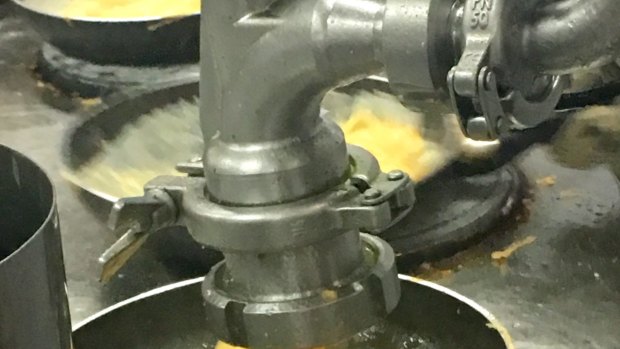
It all pales beside the amazing omelette machine, a Heath Robinson-like contraption in which 15 omelette pans complete full circles on a rotating turntable, attended by three female chefs. Plop. A dispenser drops 100 grams of omelette mixture into each pan. Plop, plop, plop. You could watch it all day.
By the time, one pan gets half way around, the omelette is ready to be folded over by one of the chefs, and by the time it completes the circuit, it is set, golden and perfectly formed, and the process starts again.
"We've made up to 8000 omelettes in one day with this machine," says Stephen proudly. The most surprising thing, in the middle of all this high-tech jiggery-pokery, is that each omelette is still gently folded over by human hand. "Each frypan lasts only 14 days," says Stephen. Staff, thankfully, last much longer.
CONSISTENCY IS KEY
The art of in-flight catering is to get the food on board as close as possible to the dishes dreamed up by the chefs. Antony McNeil works closely with SATS' Rick Stephen and his team of executive chefs to perfect each new recipe. Specific standards are drawn up for the kitchens to follow, down to the last gram.
Even so, the human element is crucial. We enter an enormous room in which uniformed and masked staff work in teams, hovering over benches completely covered with the small oblong dishes familiar to economy passengers (business and first class passengers score round plates. Woohoo).
We count 160 dishes a bench, and around 10 benches, but then it all starts to blur. Not so for the staff, who seem to know instinctively how many sliced carrots or green beans to add to each dish, without reference to the colour photo provided. A single staff member adds picked coriander leaves to dishes of curry and rice, placing them in exactly the same position every time.
Loaded onto huge trays, the main courses are moved by conveyor belt to a specialised cooling unit that brings food temperatures down to safe levels as quickly as possible. Finally, the dishes are packed into smaller trays and fitted into the familiar onboard galley carts, ready for boarding.
MEET THE FLYING SOMMELIER
Care for a drink after take-off? Er, yes please. Every year, Singapore Airlines serves $6.25 million worth of vintage Dom Perignon and $4.4 million worth of Krug Grande Cuvee to premium passengers (you have to have something to wash down all that caviar).
Michael Hill Smith, of South Australia's much-loved Shaw & Smith, one of three international wine panellists along with Britain's Oz Clarke and Hong Kong's Jeannie Cho Lee, says the airline's wine profile is slowly changing to include more Burgundy sourced from Grand Cru and premier Cru vineyards.
"We know from our surveys there is still a preference for New Zealand sauvignon blanc, Australian shiraz and bordeaux," says Hill-Smith. "But equally, you need to bring some discoveries on board for people to try. If the wine is excellent, then why not?"
The work of the International Wine Panel is amplified in the air by a growing number of keen young air sommeliers, members of the flight crew who develop a special interest in wine, and who have achieved advanced certificates with Britain's Wine & Spirit Education Trust. There's a surreal joy in discussing something so grounded and linked to the earth as wine, when such a long way above it.
THE VERDICT
Given the context – you're up in the air, pinned to a seat – dining in this rather narrow, cylindrical restaurant is surprisingly relaxing. The decor is pleasant, and the lighting flexible. Some fellow guests even fall asleep and snore through the dining experience.
Staff are graceful and charming, dressed in colourful uniforms that create a unique point-of-difference (the "Singapore Girl" factor), and give a sense of provenance. Dietary choices are accommodated to an almost OCD extent, and food is brought on trays to one's table, with breads coming separately.
Overall, the Asian-influenced dishes are the most successful. A bowl of bak chor mee noodles with pork mince and black rice vinegar is comforting and full of flavour; Hainan chicken rice comes complete with dipping sauces of dark soy, fresh chilli and lime; Singapore curry laksa smells dreamily of its rich coconut cream gravy; and a delicate dish of sea bass fillet with chin hua ham is pleasingly delicate.
Wines are efficiently poured, and the range is excellent and included in the price (although there is no sign of any pinot noir on our SYD/SNG or SNG/SYD flights). Tea is the only sticking point – it's either brought very weak, or very strong, never juuuust right.
There is a distinct lack of outdoor dining, and windows are on the small side, but that's consistent with the genre. Diners can even indulge in a wide range of entertainment – something earth-bound restaurants might like to consider in order to remain competitive. And the best bit? While dining, you are actually being delivered at high speed, from one country to another.
Score 15/20
DRINKS Excellent range, included in the price.
GO-TO DISH Bak chor mee noodles with pork and black vinegar
COST Variable, from economy to first class suites.
PRO TIP choose food particular to the departure airport such as Singaporean dishes out of Singapore, Western dishes out of Sydney.
HIGH-END DINING
At the World Gourmet Forum, we watch Italy's endlessly creative Carlo Cracco infuse lentils with smoked chestnuts and hazelnuts; and France's Georges Blanc plate a morel polenta with roast chicken breast, zucchini and asparagus.
"For me as a French chef, the sauce is very important," says Blanc, the longest-standing chef on the International Panel (and the canniest), who has held three Michelin stars for his restaurant since 1981. "It is in effect, liquid seasoning, so it must be very well adjusted to give the right balance to the food."
Chef Zhu Jun of Shanghai has mouths watering with his purse-like spring crabmeat dumplings, and India's celebrity chef Sanjeev Kapoor prepares a smoked shaam savera (spinach kofta in tomato gravy), that is a great balance of tradition with a twist. Japan's acclaimed Yoshihiro Murata approaches his dishes with all the seasonality and precision of a fine kaiseki with his trio of smoked salmon with miso yolk, firefly squid and asparagus, and squid and bamboo shoot; and Alfred Portale of New York's Gotham Bar and Grill represents his home town with a well-judged seabass with roasted fennel and blood orange emulsion. Suzanne Goin of Los Angeles' Lucques restaurant puts forward a chilled red pepper soup with aleppo chilli, chive blossoms and creme fraiche that speaks volumes for her clean, market-driven Californian approach.
If Blanc is all about the sauce, Goin is all about fresh greens. "I use watercress, arugula (rocket), herbs and young spinach, as well as a healthy dose of acid – usually citrus juice – to brighten up any dish," she says. One of the most rewarding parts of her job is that the LA Airport catering facility works with the same farmers she uses in the restaurant. "It's pretty exciting to think of our local farmers' produce being served on flights going around the world."
Next up is our own Matt Moran of ARIA in Sydney and Brisbane, with a proudly Australian comfort dish of lamb with peas, anchovy and tarragon gremolata. After 15 years of acting on the International Culinary Panel, and the creation of 700 individual dishes, he says he knows to break the process down into steps.
"The first couple of years were hard, trying to learn what you can and can't do," he says. "We now have step-by-step photographs that show where everything goes and in what order."
While a dish of braised wagyu beef cheeks is his personal favourite ("braised dishes work best" he says), he doesn't try to replicate the menus of his high-end Aria restaurants in Sydney and Brisbane. "You can't get too fancy with the food" he says. "People want to identify with what's put in front of them, so you keep it simple."
FIVE THINGS TO KNOW ABOUT WINE IN THE AIR
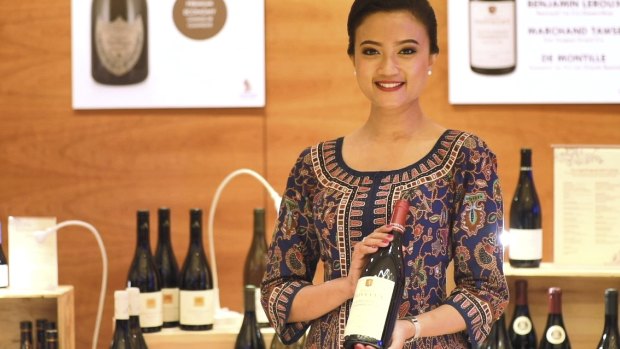
Drinking wine at 10,000 metres up on the air is delightful, but there are certain things you need to know. Here's the low-down from Michael Hill-Smith, co-founder of South Australia's Shaw & Smith Wines and Tolpuddle in Tasmania, one of the three renowned consultants on the airline's International Wine Panel.
1. Like food, your wine will not taste the same as on the ground. "Most aircraft cabins have low relative humidity, which dries out our nasal receptors, resulting in a diminished sense of smell and taste," says Hill-Smith. Hence the wines selected for Singapore Airlines are tasted in a pressurised simulation cabin or in the air itself.
2. The best-performing varietals to choose, he says, are the more aromatic. Hardness, astringency and bitterness are accentuated in the air, so Hill-Smith tends to avoid selecting acidic or tannic styles for the list. "Bright and vibrant wines with freshness and lifted fruit work well" he says. "Riesling, Australian shiraz with its soft, ripe tannins, or a contemporary pinot noir are your best choices."
3. The more you can smell, the more you can taste, so do whatever you can to increase the aromatics in the wine you are given. Glasses are often smaller than in a top restaurant, so gently swirl the wine to increase its exposure to oxygen. Red wines are often served relatively cool, so allow the wine to warm up in the glass.
4. Your best strategy is to drink less, but drink better, and stay hydrated. "A glass of very good wine helps me relax and enjoy my meal before sleeping," says Michael Hill-Smith. "But because we all dehydrate during a long flight, drinking plenty of water is a good strategy."
5. If you wake up to the pop of a champagne cork on any airline, then they're doing it wrong. The correct way to open a champagne bottle is to ease the cork out of the bottle with a phffff, not a pop. Nobody wants loud popping noises on a plane.
THE DISH DISSECTED
LAMB WITH PEAS, ANCHOVY AND TARRAGON GREMOLATA
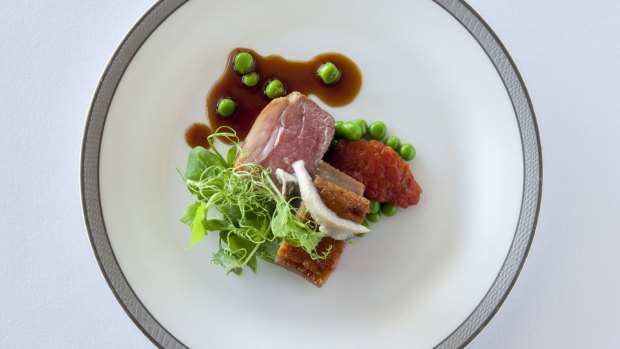
Credit: Jennifer Soo
Matt Moran's newest dish for Singapore Airlines plays to his strengths, with Australian lamb the hero, fresh garden peas the side-kick, and a modern Australian kick to the accompaniments.
"For me, food is all about texture, but you have to have balance," says the high-flying chef, who always visits the galley to chat with the staff when he's on board. "If you have something fatty and rich like lamb, you really need acidity, whether it's from vinegar, lemon, or in this case, pickled anchovy."
1. The lamb
Australian lamb loin is cut into 120-gram portions, slowly cooked sous-vide, then roasted. Blast-chilled to arrest the cooking process, it is then heated on board at 150C for 15 minutes.
2. The peas
30 grams of fresh green peas (about 70) are very quickly blanched. "Even 15 seconds too long will impact on the quality and flavour," says Moran.
3. The tomato concasse
Tomatoes are cooked down with garlic and herbs to give a little freshness and acidity on the plate.
4. The anchovy
Anchovy oil is drizzled on prior to serving and 10 grams of pickled white anchovies are used as a garnish, to provide balance.
5. The jus
30ml lamb and anchovy jus, flavoured with fresh tarragon.
6. The pea sprouts
Delicate tendrils of snow pea sprouts (three a plate) are sourced from Australian salad leaf specialists Export Fresh, and kept fresh under a damp kitchen towel.
7. Tarragon gremolata
Fresh tarragon is mixed with garlic and breadcrumbs for a textural contrast.
8. The wine match
Michael Hill-Smith suggests an Australian shiraz from the list, such as Tim Kirk's perfumed and spicy cool-climate 2016 Clonakilla O'Riada Shiraz from Canberra district. "It's fresh and vibrant, with enough acidity to cut through the higher fat content of the lamb," he says.
TOP DISHES FROM MATT MORAN'S PREMIUM MENU
Seared kingfish with nicoise salad
Fingerling potato, green bean, quail egg, cherry tomato, olive paste and pesto
Seared rack of lamb with braised lamb neck.
Sauteed eggplant with balsamic and romesco sauce
Crispy duck with gastrique (a tart, sweet caramelised sauce) with radicchio, lettuce leaves and orange
Popcorn cheesecake with yoghurt sorbet, caramel sauce with fresh raspberries and caramelised popcorn
Jill and Terry are regular columnists for Good Food in The Age and The Sydney Morning Herald, and directors of the Australian Financial Review's 2019 Australia's Top Restaurants Awards.
Jill was the cookery editor of The Times for many years, has authored 16 cookbooks, and is the founding editor of the world's first guide to sustainable and ethical restaurants, Truth, Love & Clean Cutlery.
Terry reviewed restaurants for The Independent on Sunday for nine years, and edited the Good Food Guide for nine years. Together, they eat, drink and travel in order to seek out good food wherever it may hide – even on a plane.
Jill Dupleix and Terry Durack travelled courtesy of Singapore Airlines.
Sign up for the Traveller Deals newsletter
Get exclusive travel deals delivered straight to your inbox. Sign up now.